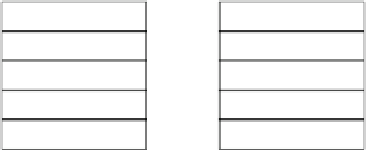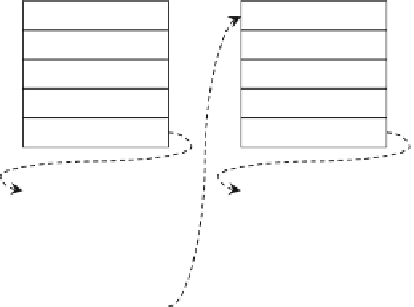Hardware Reference
In-Depth Information
Command #1
Command #3
FLAG CHECK
TRANSFER
Flag adr.
Source adr.
Check value
Destination adr.
Check interval
Transfer size
Next cmd. ptr.
Next cmd. ptr.
TRANSFER
FLAG SET
Source adr.
Flag adr.
Destination adr.
Flag value
-
Transfer size
Next cmd. ptr.
Next cmd. ptr.
Command #2
Command #4
Fig. 6.4
Transfer list function in data transfer units (DTU)
off-chip main memory, or between the on-chip CSM and off-chip main memory
behind task executions on processor cores. The DTU is also equipped with flag-set
and flag-check commands. The DTU sets a flag with a number specified in a com-
mand in the flag-set mode. In the flag-check mode, it reads the value of the flag and
checks its correspondence with the number specified in the command.
The DTU interprets a transfer list, which is a set of DTU commands placed on the
local memory. Different types of transfers can be defined in advance, and thus, the
DTU can operate independently behind a CPU. Furthermore, the setup time, such as
that to register operations, is also reduced, which results in improved performance.
Figure
6.4
shows an example of a DTU transfer list. Each command is linked by a
pointer. The following explains how the list is interpreted. First, a CPU initiates a DTU
by setting up a start-up register for the DTU and specifying an address for the first com-
mand to be interpreted. The DTU starts to perform a flag-check. It checks a flag on a
memory and compares it to the specified value in the command. The correspondence
of the two values enables the DTU to read the next command, which is specified as a
pointer address in the original command. The flag-check interval cycles are optionally
specified with the aim of restraining bus traffic or reducing power consumption. In the
next command, data are transferred from the source address to the destination address
of the specified size. As soon as the transfer has finished, the DTU reads the next com-
mand, which is another data transfer in this example. After the transfer, the DTU then
sets a flag with the specified value on the specified address.
The DTU also supports data packing to nonaligned burst transfer. Users do not need
to be concerned about the alignment of data placement in a memory, and the utilization
of a bus is also improved. In addition, it supports the stride transfer mode that enables
gathered/scattered data transfers. This is effective for applications using transfers of
rectangular regions on a memory, for example, image handling, because these transfers
can be completed with one transfer command.





Search WWH ::

Custom Search